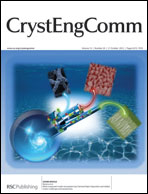Rough-surfaced Cu7Te4 nanobelts having a typical length of a few micrometers were fabricated in large quantities for the first time by using dipropylamine (DPrA) as a coordination solvent. We discussed in more detail how to optimize the experimental parameters, such as reaction temperature, the concentration of KOH and solvent, for the fabrication of pure phase, super-long Cu7Te4 nanobelts. It is found that solvent and reaction temperature played vital roles in determining the morphologies and homogeneity of the final products, while the concentration of KOH is crucial to be able to determine the phase purity (Cu7Te4 or Cu7Te5). Moreover, the formation process of Cu7Te4 nanobelts with rough surfaces was believed to include both crystal cleavage by dipropylamine and Ostwald ripening, according to the experimental observations.
You have access to this article
 Please wait while we load your content...
Something went wrong. Try again?
Please wait while we load your content...
Something went wrong. Try again?


 Please wait while we load your content...
Please wait while we load your content...